Pecan
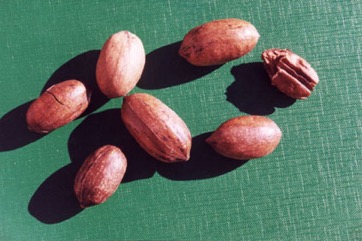
It is native to S. United States. It requires a dry subtropical climate. It suits the tropical highlands. It does best in loamy soil in an open sunny position. It is frost resistant but drought tender. They need to be in areas with warm summers. Trees grow naturally near streams in arid areas. They need deep fertile, well drained soil. Thick shelled varieties are more cold tolerant. Trees can tolerate temperatures above 38°C. Trees need to have 700 hours with a temperature under 7°C. Trees need 5,000 degree days above 10°C and a high level of sunlight during the 210 day growing season. It is grown extensively in China. It can grow with a pH between 5-8 but 6.5 is best. The soil needs to be well aerated. In PNG it is recorded between 1,400-1,600 m above sea level. It suits hardiness zones 6-11.
Also known as:
Carya pecan, Mei guo shan he tao, Nogal pecanero, Noix de pacane, Pacana, Paccan, Pagan, Pekannuss
Synonyms
- Carya illinoensis (Wangenh.) K. Koch, orth. var.
- Carya oliviformis (Michx.) Nutt.
- Carya pecan (Marshall) Engl. & Graebn.
- Carya tetraptera Liebm.
- Hicoria pecan (Marshall) Britton
- Hicoria oliviformis (Michx.) Nutt.
- Juglans illinoinensis Wangenh.
- Juglans oliviformis Michx.
- Juglans pecan Marshall
Edible Portion
- Nuts, Flavouring, Leaves - tea, Seeds - oil
Where does Pecan grow?
Found in: Africa, Asia, Australia, Brazil, Britain, Central America, China, Cuba, Dominican Republic, East Africa, Haiti, India, Israel, Mexico, Mozambique, North America, Pacific, Pakistan, Papua New Guinea, PNG, Philippines, SE Asia, South Africa, Southern Africa, South America, Uruguay, United States, West Indies, Zimbabwe
Notes: There are about 14-25 Carya species.
Status: It is a cultivated food plant. Nuts have been imported into Papua New Guinea for trial plantings. Trees at Aiyura bear irregularly.
Growing Pecan
Cultivation: Plants are normally grown from seeds. It can be grown from root-shoots. Seeds need to be fresh or they won't grow. Nuts which will grow, sink when put into water. Trees can be pruned to stop them growing too tall. Often trees are pruned to 15 m high. Trees easily suffer from zinc deficiency. Thin shelled selections are grown using cuttings grafted onto seedlings. Cross pollination normally means better nut production. Different pollinating kinds are inter planted to ensure pollen is shed while female flowers are receptive. The flowers are wind pollinated. A spacing of 10 m is suitable.
Edible Uses: The nuts are eaten raw or cooked. They are used in pies, candies, cakes, breads, ice cream, and to thicken soups. They are a source of an edible oil. The leaves are used for tea.
Production: Trees grow slowly at first while they form a taproot, then they grow more quickly. During the first 8-15 years they do not produce nuts. Trees can live for 1000 years. Grafted trees produce more quickly. A tree can produce 20-25 kg on nuts.
Nutrition Info
per 100g edible portion| Edible Part | Energy (kcal) | Protein (g) | Iron (mg) | Vitamin A (ug) | Vitamin c (mg) | Zinc (mg) | % Water |
|---|---|---|---|---|---|---|---|
| Seed | 763 | 9.3 | 2.4 | 8 | 2 | 4.5 | 3.2 |
| Seed - oil | - | - | - | - | - | - | |
| Leaves - tea | - | - | - | - | - | - |
Pecan Photos

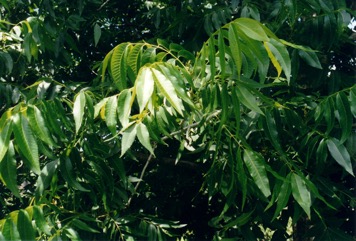
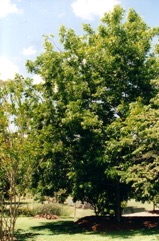
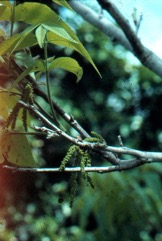
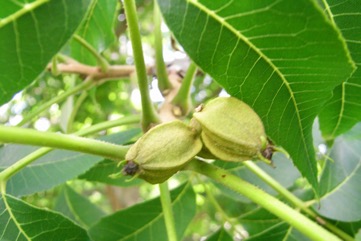
References
Beckstrom-Sternberg, Stephen M., and James A. Duke. "The Foodplant Database." http://probe.nalusda.gov:8300/cgi-bin/browse/foodplantdb.(ACEDB version 4.0 - data version July 1994) (As Hicoria pecan)
Bianchini, F., Corbetta, F., and Pistoia, M., 1975, Fruits of the Earth. Cassell. p 194
Bircher, A. G. & Bircher, W. H., 2000, Encyclopedia of Fruit Trees and Edible Flowering Plants in Egypt and the Subtropics. AUC Press. p 86
Bodkin, F., 1991, Encyclopedia Botanica. Cornstalk publishing, p 219
Bourke, R. M., Altitudinal limits of 230 economic crop species in Papua New Guinea. Terra australis 32.
Brickell, C. (Ed.), 1999, The Royal Horticultural Society A-Z Encyclopedia of Garden Plants. Convent Garden Books. p 233
Brouk, B., 1975, Plants Consumed by Man. Academic Press, London. p 221
Cheifetz, A., (ed), 1999, 500 popular vegetables, herbs, fruits and nuts for Australian Gardeners. Random House p 175
Coombes, A.J., 2000, Trees. Dorling Kindersley Handbooks. p 182
Cundall, P., (ed.), 2004, Gardening Australia: flora: the gardener's bible. ABC Books. p 334
Dendrologie 1:593. 1869 "illinoensis"
Elias, T.S. & Dykeman P.A., 1990, Edible Wild Plants. A North American Field guide. Sterling, New York p 240
Esperanca, M. J., 1988. Surviving in the wild. A glance at the wild plants and their uses. Vol. 2. p 141
Estrada-Castillon, E., et al, 2014, Ethnobotany in Rayones, Nuevo Leon, Mexico. Journal of Ethnobiology and Ethnomedicine, 10:62
Etherington, K., & Imwold, D., (Eds), 2001, Botanica's Trees & Shrubs. The illustrated A-Z of over 8500 trees and shrubs. Random House, Australia. p 184
Facciola, S., 1998, Cornucopia 2: a Source Book of Edible Plants. Kampong Publications, p 123
FAO, 1995, Edible Nuts. Non Wood Forest Products 5.
Flora of China. Vol 4 p 284www.eFloras.org
Flowerdew, B., 2000, Complete Fruit Book. Kyle Cathie Ltd., London. p 194
French, B.R., 1986, Food Plants of Papua New Guinea, A Compendium. Asia Pacific Science Foundation p 183
Glowinski, L., 1999, The Complete Book of Fruit Growing in Australia. Lothian. p 100
Gonzalez-Espinosa, M. et al, 2011, The Red List of Mexican Cloud Forest Trees. Flora and Fauna International, Cambridge. p 104
Gouldstone, S., 1983, Growing your own Food-bearing Plants in Australia. Macmillan p 149
Hedrick, U.P., 1919, (Ed.), Sturtevant's edible plants of the world. p 171 (As Carya olivaeformis)
Hibbert, M., 2002, The Aussie Plant Finder 2002, Florilegium. p 60
Hu, Shiu-ying, 2005, Food Plants of China. The Chinese University Press. p 336
Illustrated Flora of Central Texas p 747
Jardin, C., 1970, List of Foods Used In Africa, FAO Nutrition Information Document Series No 2.p 32
Kiple, K.F. & Ornelas, K.C., (eds), 2000, The Cambridge World History of Food. CUP p 1831
Lazarides, M. & Hince, B., 1993, Handbook of Economic Plants of Australia, CSIRO. p 50
Little, E.L., 1980, National Audubon Society Field Guide to North American Trees. Alfred A. Knopf. p 348
Lu Anmin, Stone, D.E., Grauke, L.J., Juglandaceae. Flora of China.
Lord, E.E., & Willis, J.H., 1999, Shrubs and Trees for Australian gardens. Lothian. p 49
Lyle, S., 2006, Discovering fruit and nuts. Land Links. p 109
Macmillan, H.F. (Revised Barlow, H.S., et al) 1991, Tropical Planting and Gardening. Sixth edition. Malayan Nature Society. Kuala Lumpur. p 313
Martin, F. W., et al, 1987, Perennial Edible Fruits of the Tropics. USDA Handbook 642 p 31, 97
Menninger, E.A., 1977, Edible Nuts of the World. Horticultural Books. Florida p 5
Miguel, E., et al, 1989, A checklist of the cultivated plants of Cuba. Kulturpflanze 37. 1989, 211-357
Mulherin, J., 1994, Spices and natural flavourings. Tiger Books, London. p 112
Plants for a Future database, The Field, Penpol, Lostwithiel, Cornwall, PL22 0NG, UK. http://www.scs.leeds.ac.uk/pfaf/
Plants of Haiti Smithsonian Institute http://botany.si.edu/antilles/West Indies (As Carya pecan)
Recher, P, 2001, Fruit Spirit Botanical Gardens Plant Index. www.nrg.com.au/~recher/ seedlist.html p 1
Schuler, S., (Ed.), 1977, Simon & Schuster's Guide to Trees. Simon & Schuster. No. 188
Segura, S., et al, 2018, The edible fruit species in Mexico. Genet Resour Crop Evol (2018) 65:1767–1793
Sharma, B.B., 2005, Growing fruits and vegetables. Publications Division. Ministry of Information and broadcasting. India. p 115
Smith, P.M., 1979, Pecan, in Simmonds, N.W., (ed), Crop Plant Evolution. Longmans. London. p 310
USDA, ARS, National Genetic Resources Program. Germplasm Resources Information Network - (GRIN). [Online Database] National Germplasm Resources Laboratory, Beltsville, Maryland. Available: www.ars-grin.gov/cgi-bin/npgs/html/econ.pl (10 April 2000)
van Wyk, B., 2005, Food Plants of the World. An illustrated guide. Timber press. p 122
Wickens, G.E., 1995, Edible Nuts. FAO Non-wood forest products. FAO, Rome. p 23, 124
World Checklist of Useful Plant Species 2020. Royal Botanic Gardens, Kew
Young, J., (Ed.), 2001, Botanica's Pocket Trees and Shrubs. Random House. p 201